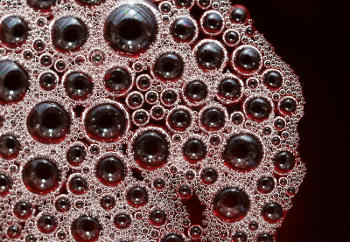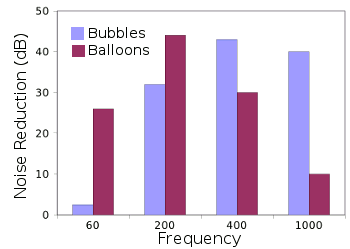
Bubble Noise Reduction
June 7, 2011 There are quite a few similarities between optics and acoustics. In optics, when a light ray reaches an interface between media of two different refractive indices, part of the ray is transmitted, and part is reflected. There's a simple equation that gives the fraction of light reflected RR = [(n1 - n2)/(n1 + n2)]2where n1 is the source medium of the light ray, and n2 is the medium that it's entering. You can reduce the reflection by putting an intermediate layer of refractive index (n1⋅n2)1/2 between the two media. For example, the reflection of window glass (n = 1.5) can be reduced with a layer of n = 1.225, since air has a refractive index of 1.0. An old electrical engineer told me that this is just impedance matching applied to optics. Acoustical reflection acts similarly, except the important factor is not refractive index difference, but the difference in the product of the speed of sound v and density ρ. This product is the acoustic impedance Z of the material
Z = ρvIf we assume that the sound waves are much smaller in wavelength than the size of the acoustical material, just like the wavelength of light is much smaller than a piece of window glass, we can calculate the reflectance,
R = (Z2 - Z1)/(Z2 + Z1)Since the acoustic impedance of water is more than 3,000 times that of air, air bubbles in water will reflect nearly all sound, inverting the phase; that's because R ≈ -1. A wall of bubbles will block sound from the other side, provided, however, that the size of the bubble is at least as large as the wavelength as the sound wave.
 | Nature imitating art. Photograph by Friedrich Böhringer, via Wikimedia Commons. |
References:
- B. Würsig, C.R. Greene Jr. and T.A. Jefferson, "Development of an air bubble curtain to reduce underwater noise of percussive piling," Marine Environmental Research, vol. 49, no. 1 (February,2000), pp. 79-93
- Kevin M. Lee, Kevin T. Hinojosa, Mark S. Wochner. Theodore F. Argo IV and Preston S. Wilson, "Using bubbles to reduce underwater noise," Paper 2aUWb11 of the 161st Meeting of the Acoustical Society of America, May 24, 2011.
